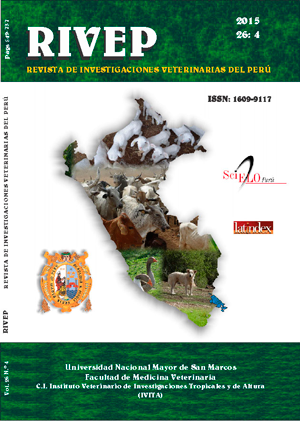Effect of Clostridium perfringens antigens and acid retinoic on IgA expression in the intestinal mucosa of newborn alpacas (Vicugna pacos)
DOI:
https://doi.org/10.15381/rivep.v26i4.11216Keywords:
South American camelids, Clostridium perfringens, immunoglobulin A, retinoic acid, Real Time RT-PCR, relative quantificationAbstract
The aim of this study was to compare the relative expression levels of the gene from exon 1 of the IgA in the intestinal epithelium of baby alpacas untreated and treated orally with Clostridium perfringens antigens and all-trans retinoic acid (ATRA). Thirty two animals were sampled: 14 treated (6 of 1 day old and 8 between 7-14 days old) and 18 untreated (10 of 1 day old and 8 between 7-14 days old). The animals were slaughtered after one week of the treatment and 2 cm of the jejunum was collected and kept at -196 °C. Total RNA was extracted from each sample using the TRIzol® method and complementary DNA (cDNA) was synthesized. PCR and RT-PCR Real Time were conducted using specific oligonucleotides designed for the detection of exon 1 of the region Fc IgA in the alpaca. The quantification of the relative expression by normalization with GAPDH gene mRNA and the relative expression calculations were performed using the comparative Ct method (2-ΔΔCt). The results showed that the administration of C. perfringens antigens and ATRA exerts positive immunomodulatory effect of IgA on the intestinal mucosa of treated baby alpacas. Animals of both age groups showed higher IgA mRNA production with respect the non-treated animals (p<0.05).Downloads
Downloads
Published
Issue
Section
License
Copyright (c) 2015 Roberto Lázaro B., Alberto Manchego S., Danilo Pezo C., Juan More B., Gina Castro S., Juan Siuce M., Nieves Sandoval C.

This work is licensed under a Creative Commons Attribution-NonCommercial-ShareAlike 4.0 International License.
AUTHORS RETAIN THEIR RIGHTS:
a. Authors retain their trade mark rights and patent, and also on any process or procedure described in the article.
b. Authors retain their right to share, copy, distribute, perform and publicly communicate their article (eg, to place their article in an institutional repository or publish it in a book), with an acknowledgment of its initial publication in the Revista de Investigaciones Veterinarias del Perú (RIVEP).
c. Authors retain theirs right to make a subsequent publication of their work, to use the article or any part thereof (eg a compilation of his papers, lecture notes, thesis, or a book), always indicating the source of publication (the originator of the work, journal, volume, number and date).



